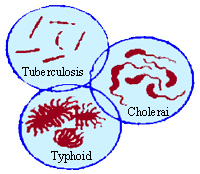|
PinkMonkey Online Study Guide-Biology
Structurally they are similar to Monera in that they
have no nuclear membrane and no membranous organelles like mitochondria
and chloroplasts. They contain chlorophyll and internal membranes called
photosynthetic lamellae or thylakoids. Besides, they also contain pigments
phycocyanine (blue) and phycoerythrin (red), which are modified to produce
brown, purple, yellow, blue or even red-coloured individuals. They are
unicellular or colonial forms which are round, rod-shaped or filamentous.
The cell wall is made up of peptidoglycan covered by a characteristic
gelatinous envelope. Some cells in the filament are colorless and are
called heterocysts which fix free atmospheric nitrogen. The fragmentations
take place at these points. They are devoid of flagella but some move
by peculiar gliding movement. Food is often stored in the form of oil
or glycogen droplets. Some can stand extremes of temperature and pH. The
method of reproduction is by binary fission. Since they reproduce extensively,
they often become dominant microorganisms in the polluted water of lakes
and ponds containing a rich supply of organic matter, forming huge populations
often called "blooms". The periodic redness in the oceans is
due to blooms of red cyanobacteria. Common examples are Anabaena, Nostoc,
Oscillatoria, etc.
Economic importance : Cyanobacteria have the following
economic importance :
(i) Heterocyst-bearing forms perform the function
of nitrogen fixation. Hence, they are used as biofertilizers in paddy
field, to increase yield.
(ii) Non-toxic forms like Spirulina are cultured
in large tanks as protein-rich animal feed.
(iii) Nostoc is cultured and used as feed for aquatic animals.
(iv) Some forms like Anabaena and Nostoc
make the drinking water poisonous, which can cause death of cattle, birds
and even humans. These forms may even interfere with water filtration
systems.

Fig. 14.12 A few pathogenic bacteria
Role of Monera
1. Role in cycling : Monera are chiefly decomposers
concerned in cycling, rotation of metabolites like carbon, hydrogen, nitrogen,
and sulphur . in nature. Life on earth would have run out were it not
for the decomposition of dead matter by bacteria and release of the elements
for resynthesis of cellular compounds. This cyclic journey of chemical
elements from biological organisms (bio) through soil or earth
crust (geo), is referred to as the biogeochemical cycle.
2. Role in symbiosis : Some forms show symbiotic
relationship such as Rhizobium in the roots of leguminous plants
or Nostoc and Anabaena in coralloid roots of Cycas,
which fix free atmospheric nitrogen into nitrates, and Escherichia
coli which inhabit the colon of the human intestine and help in synthesizing
Vitamin B.
3. Pathogenic forms : Some Monera are also pathogenic,
producing common diseases like typhoid, cholera, diphtheria, tuberculosis
and pneumonia in human beings.
List of common bacterial diseases in man
|
No. |
Disease |
Causative agents |
|
1 |
Dysentery |
Shigella dysenteriae |
|
2 |
Cholera |
Vibrio cholerae |
|
3 |
Diphtheria |
Corynebacterium diphtheriae |
|
4 |
Pneumonia |
Diplococcus pneumoniae |
|
5 |
Tuberculosis |
Mycobacterium tuberculosis |
|
6 |
Tetanus |
Clostridium tetani |
Broad control measures : The broad control measures are as follows:
(i) Use of disinfectants : These are strong chemicals
which are distributed where bacteria thrive and multiply. Some common
disinfectants used are bleach, phenol, and H2O2
peroxide.
(ii) Use of antiseptics : These are mild chemicals
which are locally applied to kill bacteria, such as alcohol and iodine.
(iii) Use of antibiotics : These are specific
drugs which are used to prevent the growth of bacteria. Some common antibiotics
are tetracyclin, streptomycin, penicillin, neomycin and erythromycin.
(iv) Sterilization : This is the common method
by which bacteria are killed by excessive heat or ultraviolet irradiation,
which disrupts and destroys the protiens and nucleic acids in the bacteria.
|
Hot water springs
Hot water springs also called thermal springs
are flows of hot water originating from active volcanic rock.
The temperature of hot water is about 85o C. This water
contains minerals (bicarbonates of calcium and magnesium) dissolved
from the rock. At this temperature only certain bacteria like Thermus,
Sulpholobus, Bacillus and some cyanobacteria can survive. Hence,
these organisms are called thermophiles. Many times hot water springs
contain sulfur. Hence, taking bath in such water is remedy for skin
diseases in humans.
|
|